祈使句、感叹句
祈使句和感叹句用

祈使句和感叹句⽤祈使句、感叹句祈使句1.定义:⽤于表达命令(最常⽤)、请求、劝告、警告、禁⽌等的句⼦叫做祈使句Eg:Go and wash your hands. (去洗你的⼿。
——命令)Be quiet, please.(Please be quiet.)(请安静。
——请求)Be kind to our sister. (对姊妹要和善。
——劝告)Watch your steps. (⾛路⼩⼼。
——警告)Look out!Danger!(⼩⼼!危险!——强烈警告,已如感叹句)Keep off the grass. (勿践草坪。
——禁⽌)No parking. (禁⽌停车。
——禁⽌)注意:祈使句的动词⼀般⽤动词原形(变否定,don't放在句⾸),句末则使⽤句号来表⽰结束.Eg:Don't play with fire.2.主语为第⼆⼈称,通常可省,please.不可省主语情况:Eg:You go over there and sit next to Tom.(2)当说话⼈强调主语或上级对下级,长者对年青⼈或⼩孩讲话时Eg:You take care when you cross the road.(3)当祈使句以Don't开头⼜要加重语⽓时Eg:Don’t you be late again next time.你下次不要再来晚了。
(4)当祈使句的主语是someone,somebody,everyone,everybody等泛指第三⼈称时Eg:Someone open that window. Everybody be here at7:30.(5)当祈使句谓语部分有副词up,down,in,out,off,away等,且这些副词置于句⾸时Eg:Out you come.3.表现形式(1)肯定结构:①Do型(即:动词原形(+宾语)+其它成分)Eg:Please have a seat here.注意:<1>有的祈使句在意思明确(如⼝号、告⽰)的情况下,动词可省略,只保留:名词短语;介词短语;名词+代词/副词/形容词;形容词+名词/代词;副词+withEg:This way Go this way, please.please(若⽤在句尾,please前加“,”)Now for it!Patience!<2>加强语⽓,动词前加doEg:Do sit down.②Be型(即:Be + 表语(名词或形容词)+其它成分)Eg:Be a good boy!③Let型(即:Let + 宾语 + 动词原形 + 其它成分)Eg:Let me help you. 让我来帮你。
祈使句和感叹句

How happy the cat is![]这只猫是多么开心啊!(感叹句)
How slowly the car is going![]汽车开的好慢!(感叹句)
How lucky he is![]他真幸运!(感叹句)
Don't let them play with fire.[]别让他们玩火。(祈使句)
Let's turn on the TV.[]我们把电视打开.(祈使句)
Please turn it down.[]请把它调低。(祈使n, Bill![]别再迟到了,比尔!
What terrible weather![]多么糟糕的天气!(感叹句)
What a beautiful picture Jill is drawing![] 吉尔画了一幅多么漂亮的画啊!(感叹句)
What a busy man Mr. Wang is![] 王先生是多么忙的人啊!(感叹句)
Tell me the truth, or I'll be angry.[]告诉我事实,否则我会生气的。(祈使句)
How clever a boy he is![]他是多么聪明的男孩啊!(感叹句)
How lovely the baby is![]这个婴儿好可爱啊!(感叹句)
How beautiful a picture Jill is drawing![]吉尔画了一幅多么漂亮的画啊!(感叹句)
Don't cross the road until the traffic lights turn green.[]直到看到绿灯,才能穿马路。(祈使句)
感叹句和祈使句的结构与特点

感叹句和祈使句的结构与特点感叹句和祈使句是常见的句子类型,在表达情感或传达命令等方面具有独特的结构和特点。
本文将介绍感叹句和祈使句的构成要素、语法结构及其在实际应用中的特点。
一、感叹句的结构与特点感叹句是用于表达惊讶、赞叹、喜悦、遗憾等情感的句子。
感叹句的结构简单明了,通常由主语和谓语构成,但其中的谓语部分往往加入了感叹语气的修饰成分,以强调情感色彩。
1. 主语部分:感叹句的主语可以是名词、代词、形容词等。
例:这个房子多么漂亮!多好的天气啊!2. 谓语部分:感叹句的谓语表示主观感受,常常是动词、形容词或副词。
例:你太厉害了!多么热闹的场面啊!3. 感叹语气的修饰成分:为了增强感叹句的感情色彩,通常会在谓语部分添加一些修饰成分,如副词、介词短语、形容词等。
例:他真是太有才华了!哇,多么壮观的烟花!二、祈使句的结构与特点祈使句是用于表达命令、请求、建议等含义的句子。
祈使句的结构简洁明确,通常直接使用动词原形,省略了主语部分,时态上则一般使用一般现在时。
1. 动词原形:祈使句常常使用动词的原形作为谓语,直接传达命令或请求。
例:请给我打个电话。
别再吵了。
2. 省略主语:由于祈使句的主语往往可以通过语境或上下文推断出来,因此通常省略不写。
例:尝尝这个美味的蛋糕。
喝完水再走。
3. 一般现在时态:祈使句通常使用一般现在时态,表示命令、请求等内容在现在的执行或发生。
例:请你冷静。
警惕火灾。
三、感叹句和祈使句的特点总结感叹句和祈使句都具有简洁明了的句子结构,语气鲜明,能够直接传达情感和命令等含义。
它们在实际应用中有以下特点:1. 感叹句和祈使句通常用于口语交流中,能够直接表达情感、命令、请求等,具有实际应用场景广泛的特点。
2. 感叹句和祈使句在书面语中也很常见,例如在文学作品、口号标语、广告宣传语等中经常使用到。
3. 在书面语中,感叹句和祈使句的使用频率较高,能够吸引读者的注意力,增强文章的表达力和感染力。
4. 感叹句和祈使句的结构简单明了,但在实际应用中仍需要注意语序、标点符号等语法问题,以确保句子表达的准确性和流畅性。
初中祈使句_感叹句
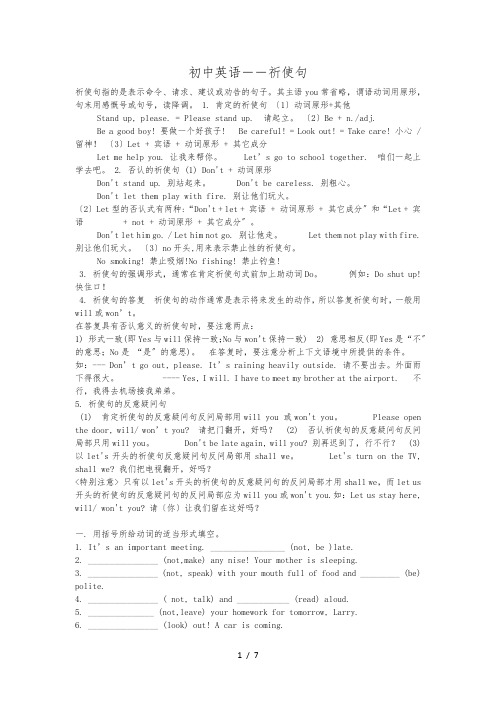
初中英语――祈使句祈使句指的是表示命令、请求、建议或劝告的句子。
其主语you常省略,谓语动词用原形,句末用感慨号或句号,读降调。
1. 肯定的祈使句〔1〕动词原形+其他Stand up, please. = Please stand up. 请起立。
〔2〕Be + n./adj.Be a good boy! 要做一个好孩子! Be careful! = Look out! = Take care! 小心 / 留神!〔3〕Let + 宾语 + 动词原形 + 其它成分Let me help you. 让我来帮你。
Let’s go to school together. 咱们一起上学去吧。
2. 否认的祈使句 (1) Don't + 动词原形Don't stand up. 别站起来。
Don't be careless. 别粗心。
Don't let them play with fire. 别让他们玩火。
〔2〕Let型的否认式有两种:“Don't + let + 宾语 + 动词原形 + 其它成分〞和“Let + 宾语 + not + 动词原形 + 其它成分〞。
Don't let him go. / Let him not go. 别让他走。
Let them not play with fire. 别让他们玩火。
〔3〕no开头,用来表示禁止性的祈使句。
No smoking! 禁止吸烟!No fishing! 禁止钓鱼!3. 祈使句的强调形式,通常在肯定祈使句式前加上助动词Do。
例如:Do shut up! 快住口!4. 祈使句的答复祈使句的动作通常是表示将来发生的动作,所以答复祈使句时,一般用will或won’t。
在答复具有否认意义的祈使句时,要注意两点:1) 形式一致(即Yes与will保持一致;No与won’t保持一致) 2) 意思相反(即Yes是“不〞的意思;No是“是〞的意思)。
语文祈使句和感叹句的区别

语文祈使句和感叹句的区别1.引言1.1 概述祈使句和感叹句是语文学习中常见的两种句子类型。
祈使句主要用于表示命令、请求或建议,而感叹句则用于表达惊奇、赞叹、感慨等情感。
虽然它们都是独立的句子形式,但它们在语法结构和表达方式上有着明显的区别。
在本文中,我们将重点探讨祈使句和感叹句的区别。
通过深入了解它们的定义和特点,我们可以更好地理解它们在语言表达中的作用和使用方法。
在接下来的章节中,我们将首先介绍语文祈使句的定义和特点。
然后,我们将转向语文感叹句的定义和特点。
通过比较这两种句子类型的不同之处,我们可以更清晰地了解它们在句子结构上的差异。
最后,我们将总结语文祈使句和感叹句的区别,并探讨对于语文学习的启示。
通过对祈使句和感叹句的研究,我们可以进一步提升我们的语言表达能力,使我们的写作和口语更加丰富多样。
在接下来的章节中,我们将逐一探讨这些内容,并希望通过本文的阐述,读者可以对祈使句和感叹句有更深入的理解。
让我们一起进入这个有趣的语文世界吧!1.2文章结构1.2 文章结构本文将分为三个主要部分来探讨语文祈使句和感叹句的区别。
在引言部分,我们将概述整篇文章的主要内容和结构,并阐明撰写本文的目的。
接下来,正文将分为两个小节:语文祈使句的定义和特点以及语文感叹句的定义和特点。
在这两个小节中,我们将详细解释祈使句和感叹句的定义,并分析它们的特点和用法。
最后,在结论部分,我们将总结语文祈使句和感叹句的区别,并进一步讨论这些知识对语文学习的启示。
通过这样的结构安排,读者可以系统地了解祈使句和感叹句的区别,并从中获取对语文学习的一些启示。
我们希望通过本文的讨论,读者能够更好地理解和运用这两种句式,从而提升自己的语文水平。
接下来,我们将开始探讨语文祈使句的定义和特点。
1.3 目的本文旨在探讨和解释语文中祈使句和感叹句的区别。
通过对这两种句子结构的定义和特点的详细分析,我们将能够更好地理解它们在语言表达中的作用和用法。
人教版 初中英语知识点:感叹句和祈使句

初中英语知识点:感叹句和祈使句知识点总结一、感叹句感叹句是用来表达喜、怒、哀、乐等强烈感情的一种句式。
尽管感叹句的表现形式多种多样,但主要的表现形式只有两种,即what和how引导的感叹句。
what修饰名词,how修饰形容词、副词或动词。
1、由感叹词what引导的感叹句。
what修饰名词或名词短语,有以下两种形式:1)What+a(an)+(形容词)+单数可数名词+主语+谓语!或是:What+名词词组+主语+谓语! 如:What a fine day it is!2) What+(形容词)+可数名词复数或不可数名词+主语+谓语! 如:What kind women they are! What nice music it is!2、由How引导的感叹句。
how用来修饰形容词、副词或动词。
其结构是:How+形容词(副词)+主语+谓语! 例如:How hard the workers are working!How clever the girl is!注意:当how修饰动词时,动词不跟着感叹词提到主语之前。
How fast the runner runs!3、what与how引导的感叹句,一般情况下可以相互转换,转换后意义不变。
(具体见下)如:What an interesting story it is!==How interesting the story is!what a beautiful building it is!==How beautiful the building is!在口语中,感叹句的主语和谓语常常省略。
如:What a nice present!(省略it is) How disappointed!(省略she is或其它可作本句主、谓的词语)二、祈使句用于表达命令、请求、劝告、警告、禁止等的句子叫做祈使句,祈使句通常省略主语,谓语动词用原形,句尾用感叹号或句号。
1、肯定结构:1)动词原形(+宾语)+其它成分。
祈使句、感叹句、反义疑问句

祈使句、感叹句、反义疑问句一、祈使句1.肯定句用动词原形,否定用Don't / Never +动词原形。
Be quite , please!Never be afraid of it!点津:祈使句的其他否定形式:①否定不定式Be sure not to be late.②no + 动名词构成简短否定祈使句No smoking !No talking!③直接用含有否定意义的动词Leave it alone!2. let 祈使句let的宾语可以是me,us ,him,her,it,them或名词,但不能是you。
Let me give you a clean towel.Let's not open the window!3.祈使句的常见句型①祈使句+and+陈述句Work harder and you'll make more progress.②祈使句+or / otherwise +陈述句One more step , and i'd beat you flat.4.带主语的祈使句①表示强调、对比或表示说话人发怒、生气等感情时,需要保留主语。
其谓语动词仍用动词原形,不受主语人称限制。
You go away!John, stand and the rest of you sit down.②强调主语或上级对下级、长者对年轻人或小孩讲话时。
John , come along with me!③someone ,somebody ,everybody, everyone,anybody等也可作祈使句的主语。
Everybody shut up!5.物动词祈使句一般来讲,祈使句都需要动词,但是有些用于口号、告示等的祈使句都是没有动词的。
Patience!Bottoms up!二、感叹句1. what 引导的感叹句①What a / an +形容词+单数可数名词+主语+谓语!What a clever boy he is!②What +形容词+不可数名词+主语+谓语!What fine weather we are having today!③What +形容词+复数名词+主语+谓语!What beautiful flowers these are!2 . how 引导的感叹句①How +形容词/ 副词+主语+谓语!How fast he is running!②How +形容词/ 副词+a / an +单数可数名词+主语+谓语!How difficult a problem it is!③How +主语+谓语!How times flies!3.没有感叹词的感叹句Good heavens!三、反义疑问句的几种特殊形式陈述部分以there开头的句子,疑问部分也用there;陈述部分是there used to ...形式时,疑问词部分用usedn't there或didn't there。
祈使句和感叹句
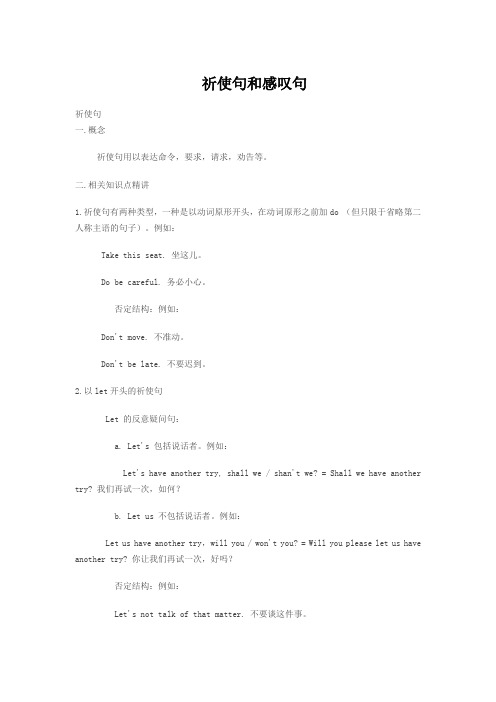
祈使句和感叹句祈使句一.概念祈使句用以表达命令,要求,请求,劝告等。
二.相关知识点精讲1.祈使句有两种类型,一种是以动词原形开头,在动词原形之前加do (但只限于省略第二人称主语的句子)。
例如:Take this seat. 坐这儿。
Do be careful. 务必小心。
否定结构:例如:Don't move. 不准动。
Don't be late. 不要迟到。
2.以let开头的祈使句Let 的反意疑问句:a. Let's 包括说话者。
例如:Let's have another try, shall we / shan't we? = Shall we have another try? 我们再试一次,如何?b. Let us 不包括说话者。
例如:Let us have another try,will you / won't you? = Will you please let us have another try? 你让我们再试一次,好吗?否定结构:例如:Let's not talk of that matter. 不要谈这件事。
Let us not talk of that matter. 你不要让我们谈这件事。
感叹句一.概念感叹句通常有what, how引导,表示赞美、惊叹、喜悦、等感情二. 相关知识点精讲1.How +形容词+ a +名词+ 陈述语序。
例如:How clever a boy he is! 他是多聪明的孩子!2.How+形容词或副词+陈述语序。
例如:How lovely the baby is! 小毛头真可爱!3.What +名词+陈述语序。
例如:What noise they are making! 他们真吵!4.What +a+形容词+名词+陈述语序。
例如:What a clever boy he is! 他是多聪明的孩子!5.What+ 形容词+复数名词+陈述语序。
祈使句与感叹句

祈使句与感叹句
祈使句是用来表示命令、请求、建议等含义的句子,通常使用动词原形作为句子的谓语动词,常用的标点符号是句号或者感叹号。
祈使句常常能够带来一种命令或者建议的语气,具有强调和直接的特点,常用于口头语言和日常交流中。
与祈使句相对应的,感叹句则用来表达某种感情或者情绪,常常包含强烈的情绪色彩,可以表达惊讶、喜悦、愤怒等各种感觉。
祈使句的用法和例句:
1. 表示命令或请求:
- 请你安静。
- 别忘了交作业。
- 快点走开!
2. 表示建议或提醒:
- 别担心,一切都会好起来的。
- 尽量保持冷静。
3. 表示反问,带有命令的意味:
- 汤姆,你能不能给我安静一下?
4. 表示请求帮助:
- 帮我一个忙,给我借一下手机。
感叹句的用法和例句:
1. 表示惊讶、赞叹:
- 多么美丽的花啊!
- 真是太神奇了!
2. 表示喜悦、满足:
- 恭喜你,你成功了!
- 真是太好了!
3. 表示疑问、困惑:
- 他怎么会这样做呢?
- 这是什么鬼东西?
4. 表示愤怒、失望:
- 真是太让人生气了!
- 真是太恶心了!
综上所述,祈使句和感叹句在语法和用法上有一些区别。
祈使句用来表达命令、请求、建议等含义,常常带有强调和直接的语气;而感叹句则用来表达强烈的情感、感情或者情绪,可以表示惊讶、喜悦、愤怒等。
在书面语中,祈使句和感叹句都能够增强文章的表达力,但在使用时需要注意适度,避免使用过多造成冗余和失衡。
一个合理运
用祈使句和感叹句的文章将会给读者留下深刻印象,使得文章更加生动有趣。
英语祈使句和感叹句

英语祈使句一、祈使句祈使句是表示命令、请求的句子。
祈使句因为对象(即主语)是第二人称you,所以通常省略。
祈使句的动词都为一般现在时,句末则使用问号来表示结束。
1,肯定结构的祈使句常以谓语动词原形开头。
列如:Stand up ,please 请起立Be careful 小心 Come here Close the doorOpen the window Wash your hands2,否定结构的祈使句常在谓语动词原形前加上Don’t。
Don't forget me 不要忘记我Don't be late for school 上学不要迟到Don't open the door3,let引导的祈使句结构,有以下几种情况:1.“Let me+动词原形”(let +宾语+动词+其他),意为“请让我……”。
Let me help you .让我帮你吧。
2.“Let’s +动词原形”,意为“让我们……”,表示建议或请求。
Let's go to school. let's play a game4,No 开头的祈使句,用来表示禁止。
No smoking禁止吸烟 No fishing禁止钓鱼二、感叹句感叹句是用来表示喜怒哀乐等强烈感情的句子,通常由how或what来引导。
◆what通常修饰名词,引导的感叹句的结构为:1. What + a(n) +形容词+可数名词的单数形式+主语+谓语+其他!2. What +形容词+可数名词的复数形式+主语+谓语+其他!3. What +形容词+不可数名词+主语+谓语+其他!◆how通常修饰副词或形容词,引导的感叹句的结构为:1. How +形容词或副词+主语+谓语!2. How +主语+谓语!感叹句练习题Ⅰ. 按要求完成下面的句子,每空一词。
1. These flowers are very beautiful. (改为感叹句)_______ _______ these flowers are!2. The little boy is very clever. (改为感叹句)_______ _______ the little boy is!3. It’s a funny story. (改为感叹句)_______ _______ _______ story it is!4. What a good girl she is! (改为同义句)_______ _______ _______ girl she is!5. How delicious the food is! (改为同义句)_______ _______ food it is!6. They are running fast. (改为感叹句)_______ _______ they are running!7. Her sister is a very lovely girl. (改为感叹句)_______ _______ lovely girl her sister is!_______ _______ her sister is!8. I have read a very interesting book. (改为感叹句)_______ _______ _______ book I have read!9. Your dictionary is very useful. (改为感叹句)_______ _______ your dictionary is!10. The children are singing and dancing happily. (改为感叹句)_______ _______ the children are singing and dancing!Ⅱ. 单项选择( )11. What a friendly person _______! We all like talking with him.A. is itB. is heC. it isD. he is( )12. _______ swimming in this river!A. How great funB. What great funC. How a great funD. What a great fun( )13. _______ sad news it is! We must try our best to help them out of trouble.A. What aB. WhatC. How aD. How( )14. What _______ fine weather we have these days!A. aB. theC. /D. an( )15. _______ lovely day! Let’s go for a walk.A. WhatB. What aC. HowD. How a( )16. _______ dangerous it is to ride on a busy road!A. WhatB. What aC. HowD. How a( )17. _______ great time we had last week!A. HowB. How aC. WhatD. What a( )18. _______ man he is!A. What strange aB. How a strangeC. What a strangeD. What strange( )19. _______ interesting it is to swim in the sea.A. HowB. What aC. WhatD. How a( )20. _______ the soup tastes!A. How goodB. How wellC. What goodD. What well。
(完整版)祈使句和感叹句

祈使句和感叹句祈使句:一、祈使句的概念:1.祈使句表示命令、请求,建议或劝告等等。
主语通常省略,谓语动词用原形,句末用惊叹号或句号,用降调.注意:有时为了加强语气或明确指出说话对象,主语you不省略,否定祈使句的主语you放在don’t 之后。
例:1.You two read the text,please . 请你们两个人读课文。
2.Don't you be late again.你可别再迟到了。
二、祈使句的结构和用法:(一)、肯定的析使句。
1.句型:动词原形(省略主语)。
例如:Stand up,please 或P1ease, stand up.请起立!Be quiet! 安静!2.有时为了加强语气,可以在动词之前加do。
例如:Do study hard.一定要努力学习。
(二)、否定的祈使句。
句型:①Don't+ 动词原形。
例如:Don't be late.别迟到。
例如:Please don`t be careless ! 请不要粗心. (please一般放在don't前)②Let`s + not + 动词原形。
Let's not say anything about it . 对于这件事,咱们什么也不要说。
③Don't let +第三人称(宾格)+动词原形或1et + 第三人称+ not + v(原)Don't 1et them play with fire .别让他们玩火。
Let them not play with fire!让他们别玩火,三、祈使句的几个常见结构:1.肯定的祈使句的反意疑问句反问部分可用will you/won’t you.eg:Come over to my home for supper with me,Will you?到我家来与我一起吃晚饭,好吗?2.否定的祈使句的反意疑问句反问部分只用will you .eg: Don't be late f or scboo1,will you? 不要迟到,好吗?3. 以Let's开头的祈使句的反意疑问句反问都分用,shall we .Let`s ,splay games,shall we? 我们一起玩游戏,好吗?4.析使句+and/or+ 简单句,相当于一个以if 引导的条件状语从句.eg:Hurry up,Or we'11 be 1ate for school.= if we don't hurry up,we'11 be late for schoo1.相关练习:一、用所给词的适当形式填空1. Please______ (open) the door.2. _____ (100k) at the picture,please .3.______ (not be) careless. 4. ______ (be)quiet,please.5. Please_____ (not watch)TV so much,Jim !6(1et) ___ me ___(have)a look at the photo.7. 1et the boy _____(go) out at night.8.Let the boy_____ _________(not go)out at night.二、句型转换A.将下列句子改为祈使句。
初三英语:感叹句和祈使句专题
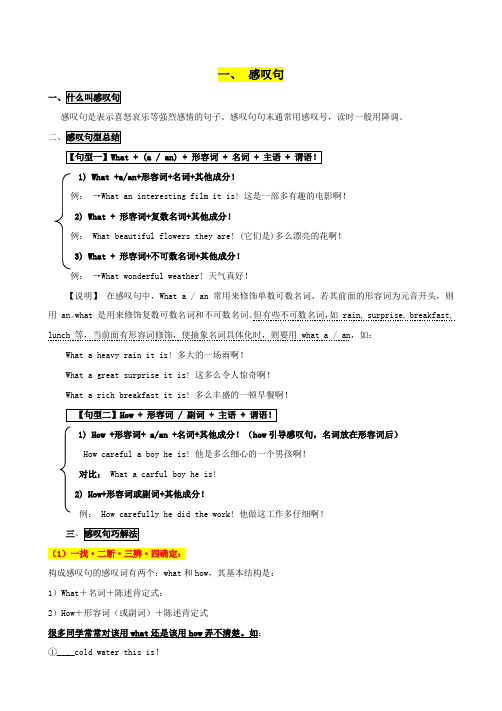
一、感叹句感叹句是表示喜怒哀乐等强烈感情的句子。
感叹句句末通常用感叹号,读时一般用降调。
1) What +a/an+形容词+名词+其他成分!例:→What an interesting film it is! 这是一部多有趣的电影啊!2) What + 形容词+复数名词+其他成分!例: What beautiful flowers they are! (它们是)多么漂亮的花啊!3) What + 形容词+不可数名词+其他成分!例:→What wonderful weather! 天气真好!【说明】在感叹句中,What a / an 常用来修饰单数可数名词,若其前面的形容词为元音开头,则用 an。
what 是用来修饰复数可数名词和不可数名词。
但有些不可数名词,如 rain, surprise, breakfast, lunch 等,当前面有形容词修饰,使抽象名词具体化时,则要用 what a / an,如:What a heavy rain it is! 多大的一场雨啊!What a great surprise it is! 这多么令人惊奇啊!What a rich breakfast it is! 多么丰盛的一顿早餐啊!1) How +形容词+ a/an +名词+其他成分!(how引导感叹句,名词放在形容词后)How careful a boy he is! 他是多么细心的一个男孩啊!对比: What a carful boy he is!2) How+形容词或副词+其他成分!例: How carefully he did the work! 他做这工作多仔细啊!三(1)一找·二断·三辨·四确定:构成感叹句的感叹词有两个:what和how,其基本结构是:1)What+名词+陈述肯定式:2)How+形容词(或副词)+陈述肯定式很多同学常常对该用what还是该用how弄不清楚。
祈使句,感叹句,反义疑问句,倒装句
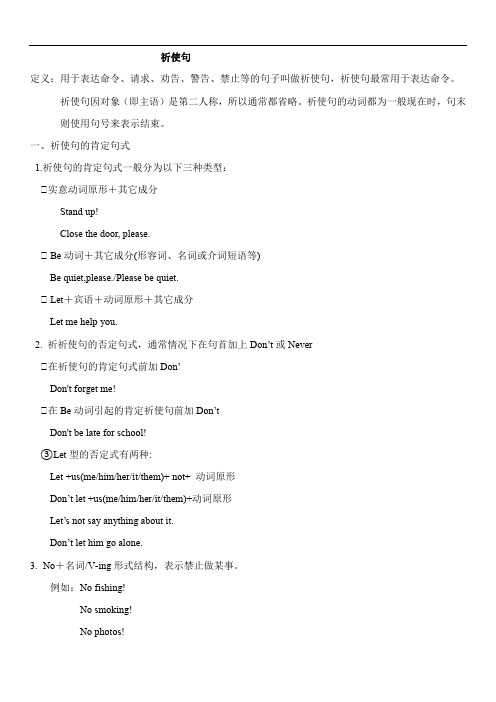
祈使句定义:用于表达命令、请求、劝告、警告、禁止等的句子叫做祈使句,祈使句最常用于表达命令。
祈使句因对象(即主语)是第二人称,所以通常都省略。
祈使句的动词都为一般现在时,句末则使用句号来表示结束。
一、祈使句的肯定句式1.祈使句的肯定句式一般分为以下三种类型:①实意动词原形+其它成分Stand up!Close the door, please.① Be动词+其它成分(形容词、名词或介词短语等)Be quiet,please./Please be quiet.① Let+宾语+动词原形+其它成分Let me help you.2. 祈祈使句的否定句式,通常情况下在句首加上Don’t或Never①在祈使句的肯定句式前加Don’Don't forget me!①在Be动词引起的肯定祈使句前加Don’tDon't be late for school!③Let型的否定式有两种:Let +us(me/him/her/it/them)+ not+ 动词原形Don’t let +us(me/him/her/it/them)+动词原形Let’s not say anything about it.Don’t let him go alone.3.No+名词/V-ing形式结构,表示禁止做某事。
例如:No fishing!No smoking!No photos!4.以may为句首的表示祝愿的祈使句.May you + 动词原形1) 祝你成功!May you succeed!2) 祝你一路平安!May you have a safe journey!5.don’t/doesn’t/didn’t后跟动词原形Please后跟动词原形练习:单项选择1. ________ stand too close to North Americans. Give them more personal space.A. Aren'tB. Didn'tC. Won'tD. Don't2. ---Is there a No. 2 bus stop near here?---Yes, there is. __________ at the second crossing, and you will find it.A. Turning leftB. Turn leftC. To turn leftD. Turns left3. —________. The baby is sleeping. I'm sorry.A. Not talkB. Not talkingC. Don't talkD. Can't talk4. — _______ late for school again, Tim! — Sorry, I promise that I _______.A. Don’t; won’tB. Don’t be; won’tC. Don’t be; don’tD. Don’t; will5. Don’t ___ shy. Everyone may make mistakes at the beginning.A. amB. isC. beD. are6. Please . The boy is studying.A. not noisyB. don’t noisyC. not to be noisyD. don’t be noisy7. —I’m leaving now. —________ you turn off the lights and the computer.A. To make sureB. Make sureC. Made sureD. Making sure8. Tony, ________, or you will get heavier.A. doesn't play sports any moreB. doesn't eat so much meatC. don't play sports any moreD. don't eat so much meat9. Don’t _______ too much TV. It’s bad for your eyes.A. watchingB. to watchC. watchD. watches10. —Would you please _______ near the river? Oh, sorry, I won’t.A. not playB.don’t playC. not to play11. — Please don’t make a noise. — ________ . I’ll be as quiet as a mouse.A. Yes, I doB. No, I don’tC. Yes, I willD. No, I won’t12. — ______, please.K-E-Y.A. What’s thisB. Spell itC. Can you spell itD. What is it13. _________ play in the street. It’s very dangerous.A. DoB. NotC. Don’tD. Doesn’t14. climb the tree! It’s too small. Come down quickly!A. Don’tB. Isn’tC. Aren’tD. Do15. —Don’t forget to close the door after school. — ________.A.OK, I won’tB.OK, I will.C.Yes, I do.D.No, I don’t.16. ---Sorry for being late again. ---__________here on time next time, or you’ll be punished.A. BeB. BeingC. To beD. Been17. _____ drive too fast .We have enough(足够的)time to get there.A. NotB. Don’tC. doesn’t18. Boys and girls, _____in bed. It’s bad for your eyesA. not readB. doesn’t readC. no readD. don’t read感叹句感叹句:表示赞美、惊叹、喜悦等感情;表达喜、怒、哀、乐、惊、恐等强烈情绪;感叹句分为两种:一种以what引导,一种以how引导。
感叹句、祈使句

一、定义:感叹句一般是用来表示说话时的喜悦、惊讶等情感。
二、用法:英语感叹句常用"what"和"how"引导,"what"和"how"与所修饰的词置于句首,其它部分用陈述句语序。
1、what引导的感叹句中,what为形容词,用作定语,修饰它后面的名词或名词词组。
1). What+a/an+形容词+可数名词单数+主语+谓语!What a nice day it is! What an interesting book that is!2). What+形容词+可数名词复数\不可数名词+主语+谓语!What beautiful flowers they are! What fine weather it is!2、how引导的感叹句中,how是副词,用作状语,修饰后面的形容词、副词或动词。
1). How +形容词\副词+主语+谓语!(主语是名词时,必须加定冠词the)How hot it is today!今天天气真热啊!How fast the boy runs!他跑得多快啊! 2). How+主语+谓语How time flies!光阴似箭!练习:一、填入适当的词完成下列感叹句。
1).____ ____ difficult homework we had yesterday!2).____ ____cute dog it is!3).____ ____ interesting the story is!4).____ ____ bad the weather in England is!5).____ ____ honest boy Tom is !6)._____ ___ tasty smell the cake gave off!二、所给句子填空,使填空句变为相应的感叹句:1. The boy swam very fast. _______ _______ the boy swam!2. Hei Longjiang looks very beautiful in winter._______ _______ Hei Longjiang looks in winter!3. It is a very useful dictionary._______ _______ _______ dictionary it is!_______ _______ _______ dictionary is!三、选择填空。
英语中常见的感叹句和祈使句

英语中常见的感叹句和祈使句感叹句和祈使句是英语中常见的句型,它们在表达情感和传达命令时起到重要的作用。
本文将介绍一些常见的感叹句和祈使句,并探讨它们的用法和特点。
一、感叹句感叹句用于表达强烈的情感或惊讶的心情。
它们通常以"What"、"How"、"So"等词开头,后面跟随形容词、副词或名词短语。
例如:"What a beautiful sunset!"(多美丽的日落啊!)"How amazing she sings!"(她唱歌多么了不起!)感叹句中的感叹词通常用于加强情感的表达,使句子更具感染力。
感叹句还可以通过调整语序来强调情感。
例如:"I have never seen such a beautiful garden!"(我从未见过如此美丽的花园!)这种调整语序的方式可以使句子更加生动有力。
二、祈使句祈使句用于表达命令、请求、建议或劝告。
它们通常以动词原形开头,没有主语。
例如:"Open the door."(开门。
)"Please be quiet."(请保持安静。
)祈使句的语气直接、简洁,具有强制性。
祈使句还可以通过加入"please"来表示礼貌或委婉。
例如:"Please pass me the salt."(请把盐递给我。
)"Please don't smoke here."(请不要在这里吸烟。
)在正式场合或与陌生人交流时,使用"please"可以使祈使句更加礼貌。
除了简单的命令外,祈使句还可以用于表达请求、建议或劝告。
例如:"Could you please help me with this task?"(你能帮我完成这个任务吗?)"Let's go for a walk."(我们一起去散步吧。
2023年初中英语句型语法精讲之感叹句与祈使句
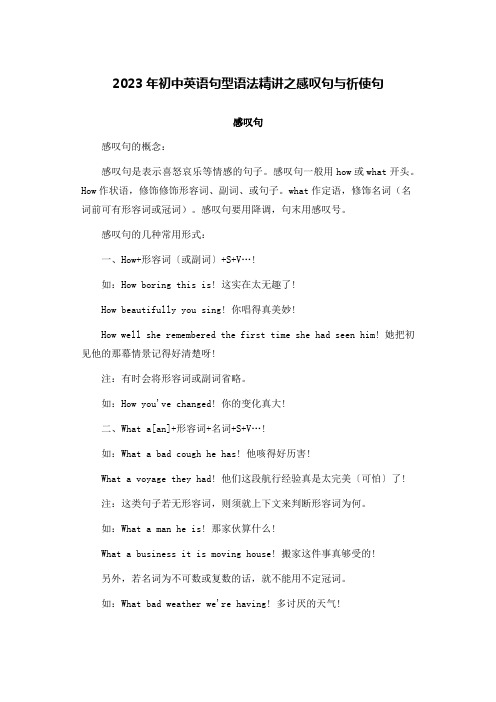
2023年初中英语句型语法精讲之感叹句与祈使句感叹句感叹句的概念:感叹句是表示喜怒哀乐等情感的句子。
感叹句一般用how或what开头。
How作状语,修饰修饰形容词、副词、或句子。
what作定语,修饰名词(名词前可有形容词或冠词)。
感叹句要用降调,句末用感叹号。
感叹句的几种常用形式:一、How+形容词〔或副词〕+S+V…!如:How boring this is! 这实在太无趣了!How beautifully you sing! 你唱得真美妙!How well she remembered the first time she had seen him! 她把初见他的那幕情景记得好清楚呀!注:有时会将形容词或副词省略。
如:How you've changed! 你的变化真大!二、What a[an]+形容词+名词+S+V…!如:What a bad cough he has! 他咳得好历害!What a voyage they had! 他们这段航行经验真是太完美〔可怕〕了!注:这类句子若无形容词,则须就上下文来判断形容词为何。
如:What a man he is! 那家伙算什么!What a business it is moving house! 搬家这件事真够受的!另外,若名词为不可数或复数的话,就不能用不定冠词。
如:What bad weather we're having! 多讨厌的天气!What fun it will be when we all go on holiday together. 我们大家一起去度假那可太有意思了。
What lovely flowers they are! 好美的花朵啊!三、How+形容词+a[an]+名词+S+V…!如:How kind a man he is! 他这个人真好!注:感叹句的省略用法 How lucky (I am)! 我是多么地幸运啊!如:What a strange man(he is)! 好奇怪的人啊!What a pity (it is) that you can't come with us! 你不能和我们一起来,真是可惜啊!How careless(it is) of him to make such a mistake! 他是不小心,才会犯下这种错误!感叹句知识体系:特殊的感叹句表达形式:1、以副词here, there, in开头的感叹句。
- 1、下载文档前请自行甄别文档内容的完整性,平台不提供额外的编辑、内容补充、找答案等附加服务。
- 2、"仅部分预览"的文档,不可在线预览部分如存在完整性等问题,可反馈申请退款(可完整预览的文档不适用该条件!)。
- 3、如文档侵犯您的权益,请联系客服反馈,我们会尽快为您处理(人工客服工作时间:9:00-18:30)。
• 2,当陈述部分否定意义的词如:unhappy, dislike,careless 等含有否定词缀在派生词 时,仍按肯定句对待,疑问部分用否定形 式。 • He looks unhappy today, doesn‟t he ? • The girl dislikes history ,doesn‟t she?
What nice music it is!
How引导的感叹句
由How引导的感叹句。
how用来修饰形容词、副词或动词。
其结构是:How+形容词(副词)+主语+谓语!
How hard the worker are working! How clever the girl is! How quickly the boy is writing! 注意:当how修饰动词时,动词不跟着感叹词提到主语之前。 How the runner runs!
• 祈使句的否定句式,通常情况下在句首加上Don‟t或 Never,一般分为以下三种类型: • 1.在祈使句的肯定句式前加Don‟t,构成Don‟t+行为动词 原形+其它成分。例如: • Don‟t say that again!别再那样说了! • 2.在Be动词引起的肯定祈使句前加Don‟t,构成Don‟t be +其它成分(形容词、名词或介词短语等)。例如:Don‟t be careless.不要粗心。 • 注意:在这种句型中be不能省略;否定副词not不可置于 be之后。 • 3.在公共场合的提示语中,否定祈使句常用No+名词/Ving形式结构,表示禁止做某事。例如: • NO PHOTOS!禁止拍照!
It作形式主语
It+is/was+形容词+(for/of sb.)+动词不定式短语
• 对于这个句型中究竟用 for还是用of,一般遵循这样的规 则:如果形容词仅仅是描述事物的形容词,如:difficult, easy,hard,important,dangerous等用for;如果形 容词是描述不定式行为者的性格、品质的,如:kind, good,nice,clever等则用of。 • It is interesting to play with snow in winter. • 冬季里玩雪是很有趣的。 It‟s important for us to keep the water clean. • 保持水质清洁对我们来说是很重要的。 It‟s very kind of you to say so. • 你这样说真是太好了。
8,陈述部分有have to +v.原 (had to + v.原),
疑问部分常用don„t +主语(didn‟t +主语)。
We have to get there at eight, don't we? 9,陈述部分若为主从复合句,疑问部分的主 语通常与主句的主语一致。 She said he would come tomorrow, didn‟t she? He told us how to get to the farm, didn‟t he?
前肯后否 前否后肯
• Jim is doing his homework, isn‟t he? • Tom wasn‟t watching TV at 8 yesterday, was he? • You went to Beijing yesterday, didn‟t he? • You knew nothing about him, did you? • There is little water in the cup, is there? • There are a few apples in the bag, aren‟t there?
4,当陈述部分是there be句型时, • There are some apples. aren‟t there? • There will be robots in people‟s home in the future, won‟t there? 5,省略的感叹句的反意疑问句一律使用否定 形式,并用be 的一般现在时。 • What a clever boy, isn‟t he? What beautiful girls, aren‟t they?
It+is/was+形容词+从句
• It is certain that he will come. • 他一定会来。 It‟s true that he may fall behind the other students. • 他真的可能落后于其他同学。 It is strange that he should say so. • 他居然这么说,真是奇怪。
祈使句的否定句式
祈使句的回答
• 祈使句的动作通常是表示将来发生的动作, 所以回答祈使句时,一般用will或won‟t。 在回答具有否定意义的祈使句时,要注意 两点:一是形式一致,即Yes与will保持一 致;No与won‟t保持一致。二是意思相反, 即Yes是不的意思;No是“是”的意思。 在回答时,要注意分析上下文语境中所提 供的条件。
what与how引导的感叹句,可以相互转换,转换后意义不变。
What an interesting story it is!=How interesting the story is!
What a beautiful building it is!=How beautiful the building is! 在口语中,感叹句的主语和谓语常常省略。如: What a nice present!(省略it is) How disappointed!(省略she is或其它可作本句主、谓的词语)
3,陈述部分为I think/ believe/ suppose 引导的宾语从句,疑问部分根据从句的情 况及整句所表达的肯定或否定意义来完成。 • I think he is at home isn‟t he? • I don‟t believe Tom can succeed, can he ?
其他it作形式主语
It作形式宾语
• it用作形式宾语的句型为:主语+谓语+it +宾语补足语+动词不定式/动名词/从 句。该句型中宾语补足语可由形容词、名 词等充当。
反意疑问句的一般情况
• 1.Tom is good at English, isn‟t he? • 2. Mike likes playing basketball, doesn‟t he? • 3. I can play basketball, can‟t I ? • 4. My father has been to Beijing twice, hasn‟t he ? • 5. This/that is a table, isn‟t it? (these, those-> they)
what修饰名词或名词短语,有以下两种形式: 1. What +a(an) +(形容词)+单数可数名词+主语+谓语!如: What an apple this is! What a fine day it is! 2. What+(形容词)+可数名词复数或不可数名词+主语+谓语!
What kind women they are!
6,祈使句的反意疑问句 Please close the door, won‟t you? Don‟t close the door, will you? • Let 开头的祈使句 • Let‟s go, shall we? • Let us go, will you? 7, 陈述部分是I am..,疑问部分要用 aren„t I. I‟m as tall as your sister, aren„t I ?
• 这一句式中的形容词位置也可换用名词;连系动 词be也可换用其它连系动词,如feel等。 • It‟s a good habit to get up early and go to bed early. • 早睡早起是好习惯。 It must be great fun to fly to the moon in a spaceship. • 乘宇宙飞船飞往月球一定很有趣。 It feels strange to have a twin sister. • 有个孪生姐妹感觉很奇怪。
前否后肯的反意疑问句如何回答
• 1.It is a fine day ,isn‟t it? • Yes, it is. No, it isn‟t. • 2. It isn‟t a fine day, is it? • Yes(不), it is. No(是的), it isn‟t. 注意:永远不可能出现yes后面跟否定形式或 者no 后面永远不可能跟肯定形式的情况。
•
--- Don‟t go out, please. It‟s raining heavily outside. • 请不要出去。外面雨下得很大。 • ---- Yes, I will. I have to meet my brother at the airport. • 不行,我得去机场接我弟弟。
反意疑问句特殊情况 1,当陈述部分含有 little/few/never/hardly/seldom/no/neith er/nobody/nothing,none等表示否定意义的 词时,疑问部分要用肯定形式。 She has few friends, does she? She has never been there,has she? There was nothing in the box, was there? None of us knows it, do we?
• • • • • • • • •
•
1.It +is /was +one‟s turn(duty,pleasure) +to do sth. 意为“该轮到某人做某事(做某事是某人的责任、愉悦的事)”。 如: It‟s your turn to be on duty tomorrow. 明天轮到你值日了。 2.It takes(sb.)some time to do sth. 意为“(某人)花……时间做某事”。如: It took me a week to finish reading the book. 我花了一周时间看完这本书。 3.It +cost/costs +sb.+some money +to do sth. 译为“某人花多少钱做某事”。 如: It cost me 260 yuan to buy the new watch. 我买这块新手表花了260元。 4.It seems /seemed +从句。 译为“看起来好像……”,此结构可以转换成“seem +动词不定式” 形式。如: It seems that he is ill.=He seems to be ill.看起 来他好像病了。
